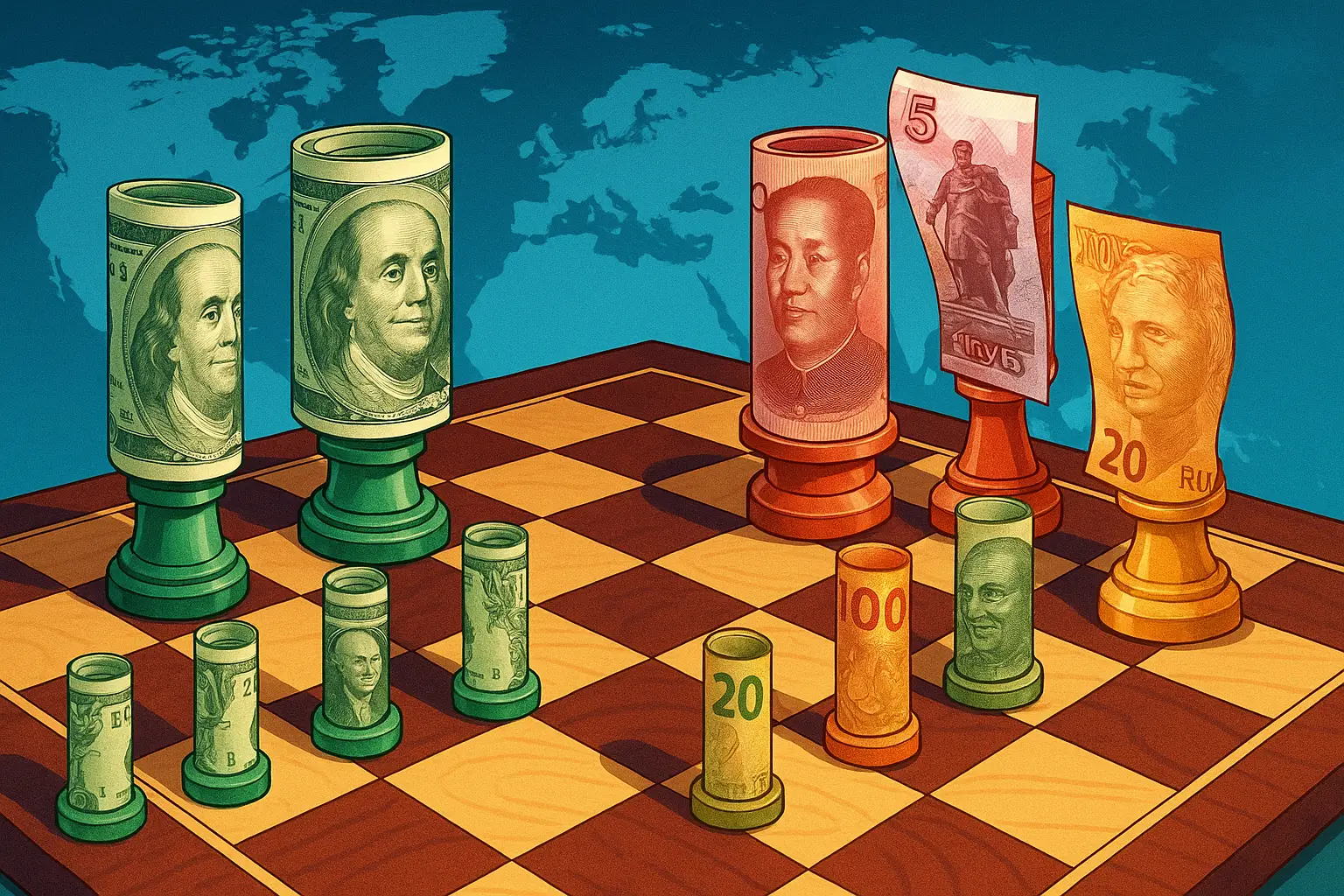You know something big is cooking when the financial headlines are spicier than a Nashville hot chicken sandwich. Lately, all eyes zoom in on BRICS+. The gang started out as the original BRICS—Brazil, Russia, India, China, and South Africa. Now, the “plus” club includes folks like Egypt, Ethiopia, Iran, and the UAE. Word on the street? They want less green in their lives. Dollar green, that is.
Let’s be honest, for decades, the U.S. dollar strutted its stuff as the world’s top playground currency. Oil, metals, coffee beans—you name it, most of the world priced it in dollars. But as of May 2025, that dominance is starting to feel a bit shaky. If you’re scrolling through X (yeah, that’s still Twitter in our hearts), you can’t miss the traders going full keyboard-warrior over what happens next.
Contents
- 1 The Battle Plan: BRICS+ vs. The Greenback
- 2 Oily Deals and Desert Diplomacy
- 3 Washington’s Counterpunch
- 4 What Does This Mean for U.S. Markets?
- 5 The Trader’s Take: Social Buzz and Keyboard Drama
- 6 The Nitty-Gritty: Why This Matters
- 7 The “X” Factor—No, Not That Kind
- 8 What Happens If The Dollar Isn’t King Anymore?
- 9 Eyes on the Next Move
The Battle Plan: BRICS+ vs. The Greenback
So, how are these emerging economies actually trying to unseat the dollar throne? First, they’re shifting trade settlements from dollars to local currencies. This isn’t just a theory; it’s happening right now. China and Russia already trade almost 80% of their stuff in yuan or rubles, sidestepping the dollar like a pothole in midtown Manhattan.
They’re backing up this move with tech. Think “BRICS Pay”—a payment messaging system built to move money in their own currencies. Forget about SWIFT and its Western trappings, they say. If BRICS+ can make these tools work at scale, the dollar’s beach vacation could get cut short.
But the crew isn’t stopping there. The New Development Bank (NDB), their version of the IMF-meets-World Bank, is rolling out more loans in local coins than ever. You need infrastructure financing for a shiny new port or highway? The NDB is happy to drop dollars for rupees, reals, or yuan, thank you very much.
Oily Deals and Desert Diplomacy
Now, let’s zoom in on Saudi Arabia. This oil juggernaut just attended a major BRICS meet-up in Brazil. Everyone expected them to bring their famous golden handshake and join BRICS+ officially. Nope. The Saudis are playing the field. They want to charm both BRICS+ and Washington, especially with brawny arms and nuclear deals hanging in the balance. Smart, right? You don’t give up the U.S. alliance for free dinner.
Even so, the market knows that if Riyadh ever shifts its oil sales out of dollars, we’d see real ripples. After all, the sheer amount of oil Saudi Arabia sells makes it a sort of currency kingpin. If they ring the bell for non-dollar trade, loads of others may follow.
Washington’s Counterpunch
U.S. leadership isn’t just sitting back with a bag of popcorn. President Trump, never known for subtlety, already threatened 100% tariffs on any BRICS+ play to undermine the dollar. Talk about drawing a line in the sand. The message: mess with the greenback, and you pay—literally.
There’s plenty at stake for U.S. policymakers. The dollar’s top-dog status let America borrow at super-low rates and finance its budget without breaking a sweat. If demand for dollars starts to slide as trade gets sliced up into other currencies, things could get messy.
Federal Reserve officials already watch these headlines like hawks. Every time BRICS+ makes another public move, the debate heats up on whether the U.S. needs higher interest rates to keep global investors interested in buying dollars and Treasuries.
What Does This Mean for U.S. Markets?
You guessed it—it’s complicated.
- A shrinking role for the dollar means global traders might shift some of their portfolios into other currencies. This could drive the dollar’s value down, making imports pricier for Americans.
- U.S. interest rates might spike as the Feds work harder to lure buyers for federal debt.
- If investors start moving cash into “BRICS+” currencies or assets, the flow of money out of U.S. bonds and stocks could pick up speed.
These aren’t just distant academic risks. Already, some trading desks hedge their bets, bracing for more volatility if oil or commodities suddenly get priced in a split of rubles, yuan, or—who knows—Brazilian reals.
The Trader’s Take: Social Buzz and Keyboard Drama
Of course, no global shakeup would be complete without a full-throttle debate on X. Folks love drama, and BRICS+ is giving them plenty.
- Some big-name traders argue the dollar is still “too big to fail” and that logistics alone will keep it on top.
- Others are bullish on a “multi-currency” future. They’re stacking up on gold, yuan, and even crypto to ride the coming wave.
- Conspiracy theories? Oh, those are out in full force—some users claim secret backroom summits are already plotting to crash the greenback.
Everyone’s got a hot take, and rumor mills grind away daily. But behind the memes and keyboard face-offs, a real shift is happening in how global commerce ticks along.
The Nitty-Gritty: Why This Matters
All these moves mean a few things anyone with a stake in U.S. markets should watch:
- If BRICS+ nations really start paying each other in yuan, rupee, or riyal, it chips away at the dollar’s status as the planet’s go-to “reserve” currency.
- Governments and businesses may start holding less dollar debt, and U.S. borrowing costs could rise.
- U.S. investments—think Treasuries, real estate, and even tech startups—could face tougher competition from emerging markets, especially if the NDB ramps up lending.
Don’t forget the psychological factor. If the world starts seeing the dollar as just another currency, that changes how central banks build their reserves and how companies plan cross-border deals.
The “X” Factor—No, Not That Kind
Maybe most fascinating: this financial shuffle has captured social media’s imagination. Visit any finance thread on X and you’ll find endless threads debating which country will bail first, or whose bonds will tank. Some see a currency apocalypse. Others see a new chance for diversification and growth.
Turns out, fear and excitement both sell. Each new headline is jet fuel for more market speculation. So, whether you’re a hedge fund shark or a humble ETF investor, you can’t afford to sleep on these developments.
What Happens If The Dollar Isn’t King Anymore?
Let’s say the BRICS+ plot actually works. They get enough momentum, and suddenly, the dollar’s not the only heavyweight in town.
- U.S. government borrowing gets pricier. Taxpayers may feel the squeeze.
- American companies with huge international footprints will have to factor in new currency risks and costs.
- Everyday consumers? Higher prices for imported stuff could start creeping into store aisles faster than you can click “add to cart.”
- On the upside, some exporters might win big if the dollar drops, making “Made in USA” products cheaper abroad.
Still, don’t expect a Hollywood ending just yet. The global system has inertia. Networks, institutions, and trust, all heavily favor the dollar—for now. And, as the Saudis show, nobody wants to jump the fence until they know the grass is really greener.
Eyes on the Next Move
The truth? No one can predict every twist. But one thing is crystal clear: the old playbook where the dollar ruled all is getting a 2025-size rewrite. BRICS+ is serious, and Washington’s threats prove everyone’s taking it seriously.
Traders, policymakers, even armchair economists know that every fresh BRICS+ headline can move markets, and sometimes, entire economies. So keep your notifications on, your charts ready, and maybe, finally open that foreign-currency brokerage account your cousin in Singapore won’t stop raving about.
Markets hate uncertainty, but they love opportunity. Whether the dollar ends up defending its crown or shares the spotlight with a few new faces, it’s a wild ride. Stay buckled in.


